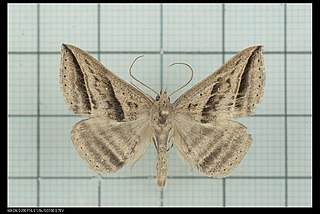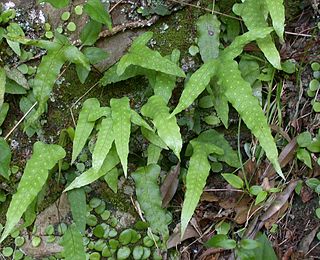
Calliandra is a genus of flowering plants in the pea family, Fabaceae, in the mimosoid clade of the subfamily Caesalpinioideae. It contains about 140 species that are native to tropical and subtropical regions of the Americas.

Olea capensis, the black ironwood, is an African tree species in the olive family Oleaceae. It is widespread in sub-Saharan Africa: from the east in Somalia, Ethiopia and Sudan, south to the tip of South Africa, and west to Cameroon, Sierra Leone and the islands of the Gulf of Guinea, as well as Madagascar and the Comoros. It occurs in bush, littoral scrub and evergreen forest.

Fissidens is a genus of haplolepideous mosses (Dicranidae) in the family Fissidentaceae.
Hypidalia is a genus of moths in the family Erebidae erected by George Hampson in 1901.

Clepsis is a genus of moths belonging to the family Tortricidae. It includes several notable pest species.
Craticula is a genus of diatom that lies on or in the top layers of sediments in the freshwater to brackish water environments it inhabits. In addition to frustule morphology the genus differs from closely related species by its sexual reproduction and movement in response to light.

Blasticorhinus is a genus of moths of the family Erebidae.
Carsina is a genus of moths of the family Erebidae. The genus was erected by George Hampson in 1924.

Selliguea is a fern genus in the family Polypodiaceae. The type species is Selliguea feei.
Hypidalia enervis is a moth of the subfamily Arctiinae first described by Schaus in 1894. It is found in Brazil and Paraguay.
Clepsis enervis is a species of moth of the family Tortricidae. It is found in Nuevo León, Mexico.
Cyperus rigidellus is a sedge of the family Cyperaceae that is native to Australia.

Stygnocorini is a tribe of dirt-colored seed bugs in the family Rhyparochromidae. There are about 14 genera and more than 60 described species in Stygnocorini.

Protea enervis, also known as the Chimanimani sugarbush, is a flowering shrub. It is native to the Chimanimani Mountains straddling Zimbabwe and Mozambique, and grows at altitudes of 1,680 to 2,000 metres.

Carex muehlenbergii is a species of flowering plant, it is a type of sedge. It is a grass-like plant in the family Cyperaceae. Its common names include sand sedge, Muhlenberg's sedge.
Mahua is a genus of moss belonging to the family Sematophyllaceae.
Lasiosomus is a genus of true bugs belonging to the family Rhyparochromidae.
Bufonia is a genus of flowering plants belonging to the family Caryophyllaceae.
Cyperus enervis is a species of sedge that is endemic to eastern Australia.









